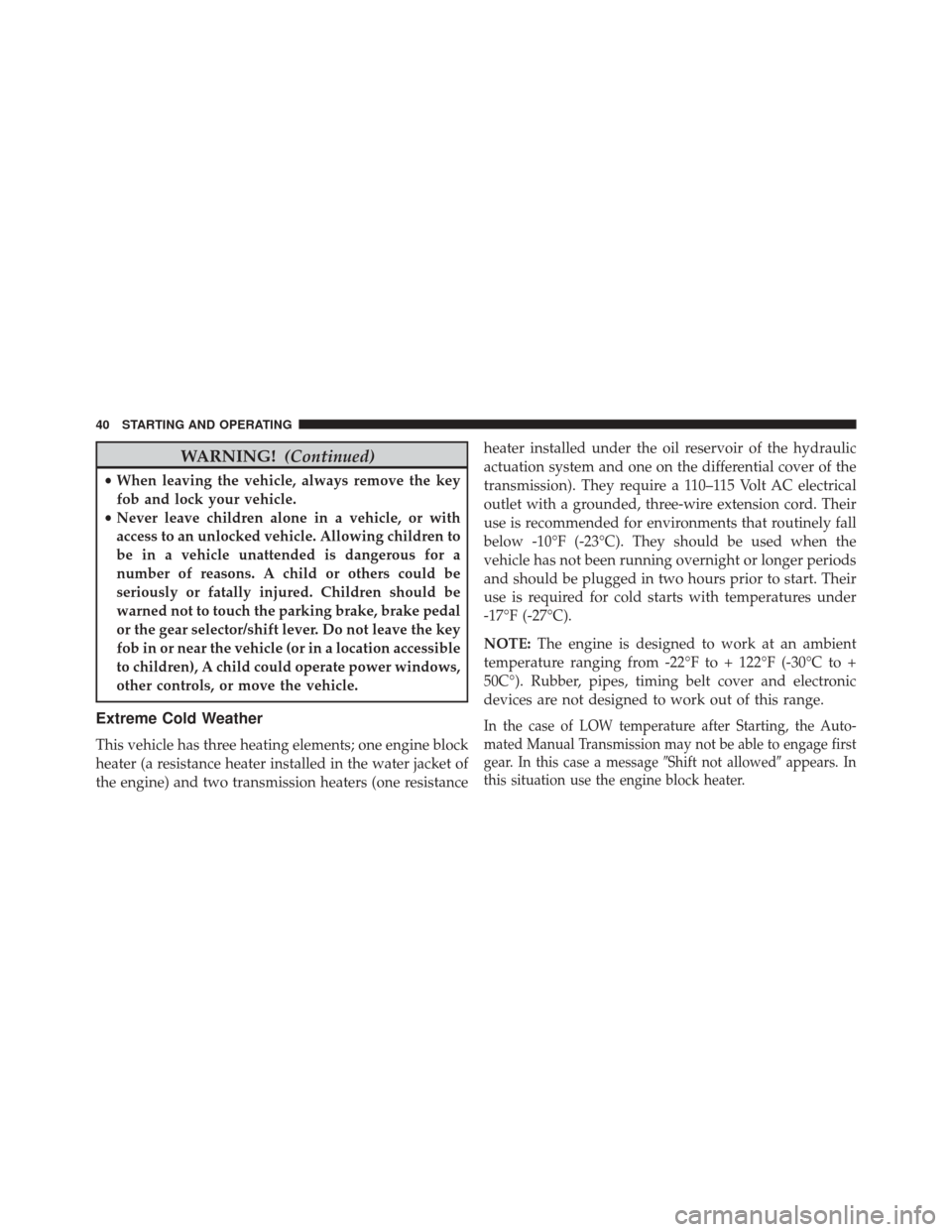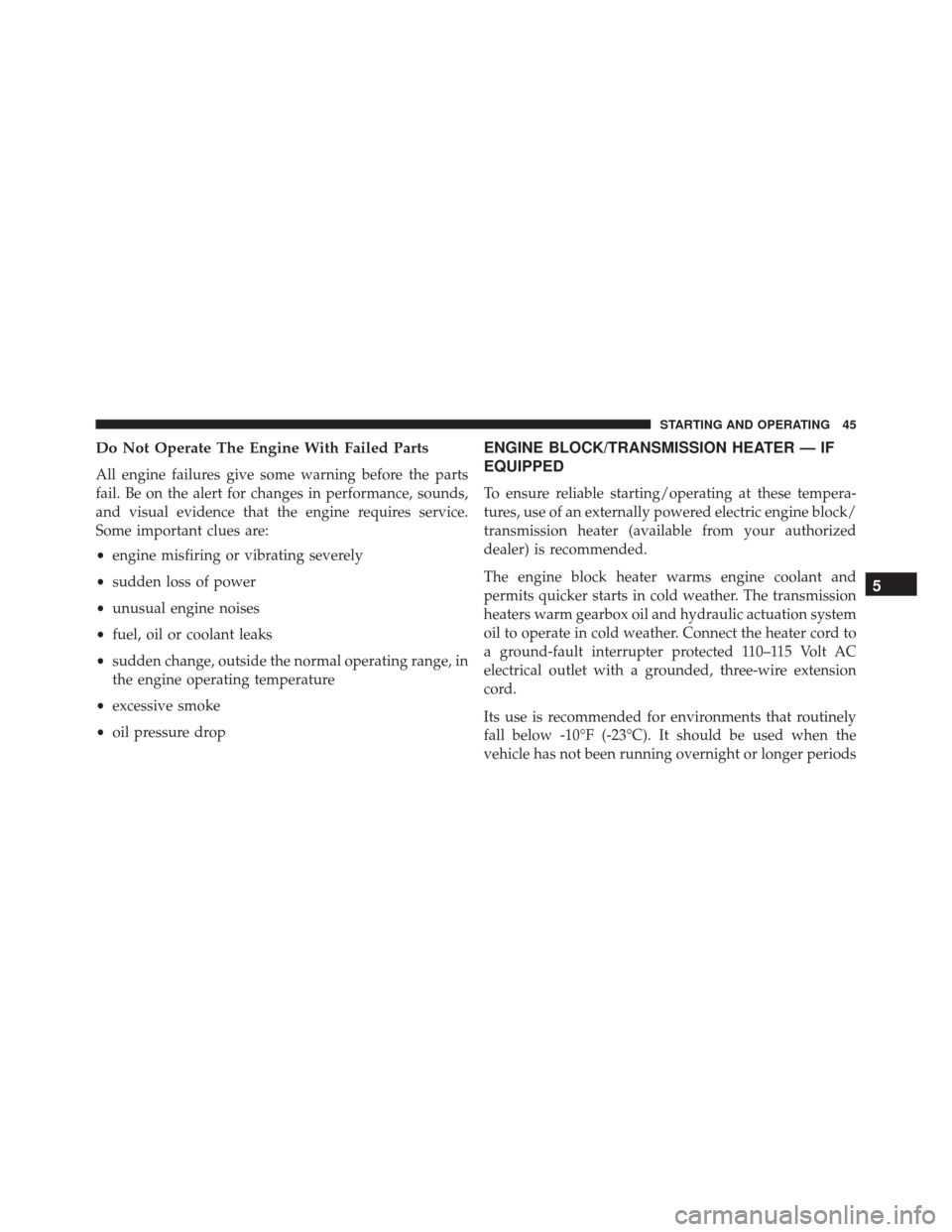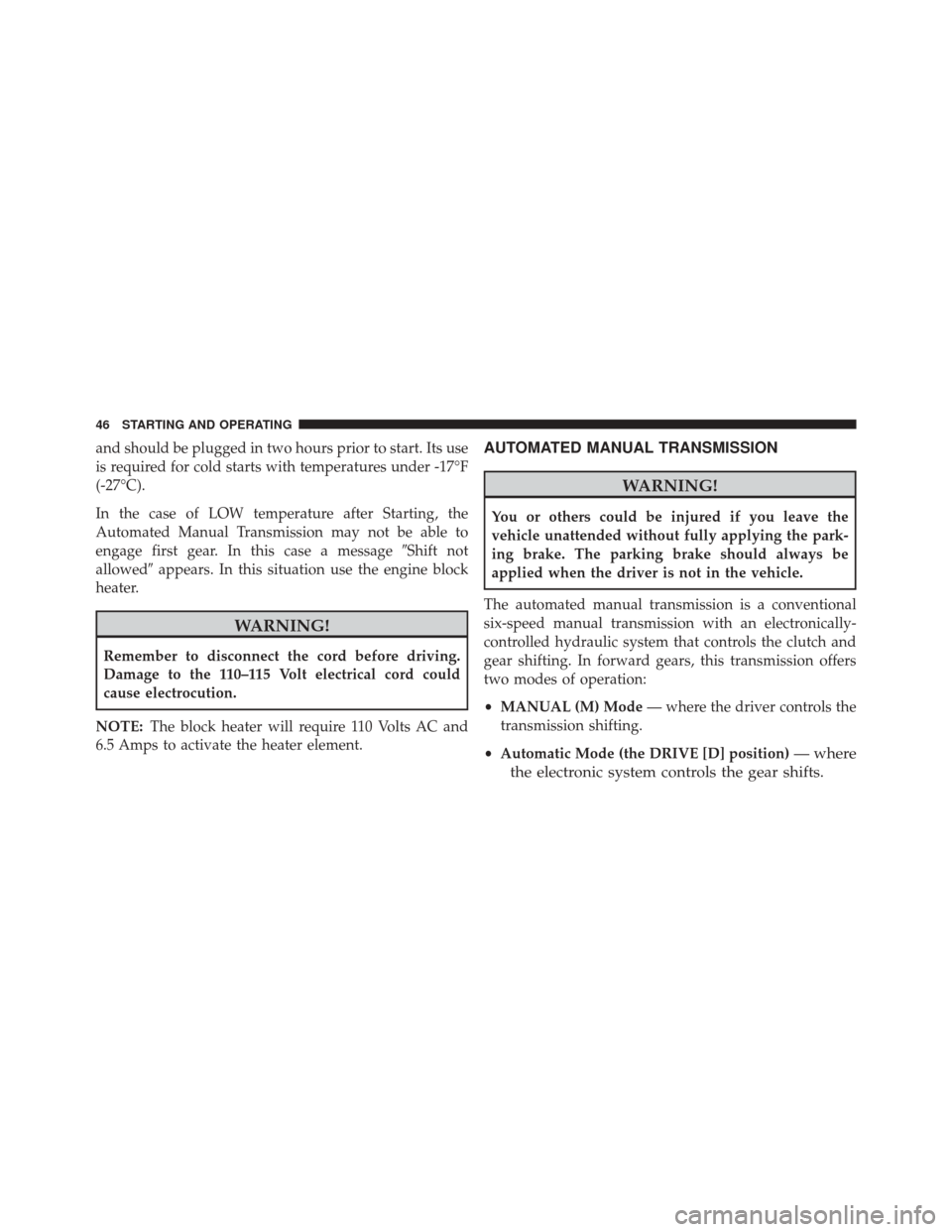Page 37 of 130
STARTING AND OPERATING
CONTENTS
�STARTING PROCEDURES .................37
▫ Normal Starting Procedure ................38
▫ Starting Fluids ........................39
▫ Extreme Cold Weather ...................40
� NORMAL OPERATION ...................41
▫ Cold Weather Precautions ................41
▫ Engine Idling .........................43
▫ Stopping The Engine ...................43
▫ Cooling System Tips — Automated Manual
Transmission .........................44 �
ENGINE BLOCK/TRANSMISSION HEATER — IF
EQUIPPED ............................45
� AUTOMATED MANUAL TRANSMISSION .....46
▫ Gear Ranges .........................48
▫ Parking The Vehicle .....................54
▫ Instrument Cluster Messages ..............56
▫ Towing The Vehicle .....................60
� FUEL REQUIREMENTS ...................60
▫ Fuel Specifications .....................62
▫ Biodiesel Fuel Requirements ...............63
5
Page 41 of 130

6. Check that the oil pressure warning light has turnedoff.
7. Release the parking brake.
To start the engine if the transmission is faulty, the
“Delayed startup” procedure may be required.
NOTE: Not all Transmission Failures requires the “De-
layed startup” Procedure, it depends on the type of
failure.
(refer to �Instrument Cluster Messages� under�Auto-
mated Manual Transmission� in this section for further
information):
• Begin with the key in the OFF position.
• Press and hold the brake pedal. •
Turn the key to the START/AVV position and hold it
there for at least seven seconds with the brake de-
pressed. The engine will start, and the transmission
will operate in recovery mode (maximum gear permit-
ted = 3rd, automatic mode not available). If the engine
does not start, contact your authorized dealer.
Starting Fluids
The engine is equipped with a glow plug preheating
system. If the instructions in this manual are followed,
the engine should start in all conditions and no type of
starting fluid should be used.
WARNING!
• Do not leave children or animals inside parked
vehicles in hot weather. Interior heat build up may
cause serious injury or death.
(Continued)
5
STARTING AND OPERATING 39
Page 42 of 130

WARNING!(Continued)
•When leaving the vehicle, always remove the key
fob and lock your vehicle.
• Never leave children alone in a vehicle, or with
access to an unlocked vehicle. Allowing children to
be in a vehicle unattended is dangerous for a
number of reasons. A child or others could be
seriously or fatally injured. Children should be
warned not to touch the parking brake, brake pedal
or the gear selector/shift lever. Do not leave the key
fob in or near the vehicle (or in a location accessible
to children), A child could operate power windows,
other controls, or move the vehicle.
Extreme Cold Weather
This vehicle has three heating elements; one engine block
heater (a resistance heater installed in the water jacket of
the engine) and two transmission heaters (one resistance heater installed under the oil reservoir of the hydraulic
actuation system and one on the differential cover of the
transmission). They require a 110–115 Volt AC electrical
outlet with a grounded, three-wire extension cord. Their
use is recommended for environments that routinely fall
below -10°F (-23°C). They should be used when the
vehicle has not been running overnight or longer periods
and should be plugged in two hours prior to start. Their
use is required for cold starts with temperatures under
-17°F (-27°C).
NOTE:
The engine is designed to work at an ambient
temperature ranging from -22°F to + 122°F (-30°C to +
50C°). Rubber, pipes, timing belt cover and electronic
devices are not designed to work out of this range.
In the case of LOW temperature after Starting, the Auto-
mated Manual Transmission may not be able to engage first
gear. In this case a message �Shift not allowed�appears. In
this situation use the engine block heater.
40 STARTING AND OPERATING
Page 43 of 130
NOTE:The engine and transmission block heater cord is
a factory installed option. If your vehicle is not equipped,
heater cords are available from your authorized
MOPAR® dealer.
• A 12 Volt heater built into the fuel filter housing aids in
preventing fuel gelling. It is controlled by a built-in
thermostat.
• A Diesel Pre-Heat system both improves engine start-
ing and reduces the amount of white smoke generated
by a warming engine.
NORMAL OPERATION
Observe the following when the diesel engine is operat-
ing.
• All message center lights are off.
• Malfunction Indicator Light (MIL) is off.
• Generic Warning Light is off. •
Engine Oil Pressure telltale is not illuminated.
Cold Weather Precautions
Operation in ambient temperature below 32°F (0°C) may
require special considerations. The following charts sug-
gest these options:
Fuel Operating Range
NOTE: Use “Ultra Low Sulfur Diesel Fuels” ONLY.
Fuel Operating Range Chart
5
STARTING AND OPERATING 41
Page 46 of 130

Cooling System Tips — Automated Manual
Transmission
To reduce potential for engine and transmission over-
heating in high ambient temperature conditions, take the
following actions:
•City Driving
— When stopped, shift the transmis-
sion into NEUTRAL and increase engine idle
speed.
• Highway Driving— Reduce your speed.
•Up Steep Hills— Select a lower transmission gear.
•Air Conditioning— Turn it off temporarily. Do Not Operate The Engine With Low Oil
Pressure
If the low oil pressure warning light turns on while
driving, stop the vehicle and shut down the engine as
soon as possible. A chime will sound when the light turns
on.
NOTE:
Do not operate the vehicle until the cause is
corrected. This light does not show how much oil is in the
engine. The engine oil level must be checked under the
hood.
CAUTION!
If oil pressure falls to less than normal readings, shut
the engine off immediately. Failure to do so could
result in immediate and severe engine damage.
44 STARTING AND OPERATING
Page 47 of 130

Do Not Operate The Engine With Failed Parts
All engine failures give some warning before the parts
fail. Be on the alert for changes in performance, sounds,
and visual evidence that the engine requires service.
Some important clues are:
•engine misfiring or vibrating severely
• sudden loss of power
• unusual engine noises
• fuel, oil or coolant leaks
• sudden change, outside the normal operating range, in
the engine operating temperature
• excessive smoke
• oil pressure drop
ENGINE BLOCK/TRANSMISSION HEATER — IF
EQUIPPED
To ensure reliable starting/operating at these tempera-
tures, use of an externally powered electric engine block/
transmission heater (available from your authorized
dealer) is recommended.
The engine block heater warms engine coolant and
permits quicker starts in cold weather. The transmission
heaters warm gearbox oil and hydraulic actuation system
oil to operate in cold weather. Connect the heater cord to
a ground-fault interrupter protected 110–115 Volt AC
electrical outlet with a grounded, three-wire extension
cord.
Its use is recommended for environments that routinely
fall below -10°F (-23°C). It should be used when the
vehicle has not been running overnight or longer periods
5
STARTING AND OPERATING 45
Page 48 of 130

and should be plugged in two hours prior to start. Its use
is required for cold starts with temperatures under -17°F
(-27°C).
In the case of LOW temperature after Starting, the
Automated Manual Transmission may not be able to
engage first gear. In this case a message�Shift not
allowed� appears. In this situation use the engine block
heater.
WARNING!
Remember to disconnect the cord before driving.
Damage to the 110–115 Volt electrical cord could
cause electrocution.
NOTE: The block heater will require 110 Volts AC and
6.5 Amps to activate the heater element.
AUTOMATED MANUAL TRANSMISSION
WARNING!
You or others could be injured if you leave the
vehicle unattended without fully applying the park-
ing brake. The parking brake should always be
applied when the driver is not in the vehicle.
The automated manual transmission is a conventional
six-speed manual transmission with an electronically-
controlled hydraulic system that controls the clutch and
gear shifting. In forward gears, this transmission offers
two modes of operation:
• MANUAL (M) Mode — where the driver controls the
transmission shifting.
• Automatic Mode (the DRIVE [D] position)
— where
the electronic system controls the gear shifts.
46 STARTING AND OPERATING
Page 49 of 130

NOTE:In either mode, there is no clutch pedal; the
electronic system always controls the clutch operation.
Shift Lever/Transmission Gear Position
The transmission shift lever has REVERSE (R), NEU-
TRAL (N), DRIVE (D) and MANUAL (M) positions.
In the MANUAL (M) position, the lever can be toggled
rearward or forward (+/-) to upshift or downshift the
transmission to the next gear.
With the key ON and the engine OFF the shift lever can
be moved freely from NEUTRAL (N) to DRIVE (D) or
REVERSE (R), however the transmission will not actually
shift unless the brake pedal is pressed. Therefore, the
shift lever and the Electronic Vehicle Information Center
(EVIC) display may not correspond to the actual trans-
mission gear range. With the engine running transmis-
sion shifts are allowed even if the brake pedal is not
pressed. NOTE:
•
The Automated Manual Transmission must be in
NEUTRAL (N) to start the vehicle.
• The actual transmission gear range (R, N, D, 1, 2, 3, 4,
5, or 6) is displayed in the EVIC whenever the engine
is running.
• When the key is turned OFF the transmission remains
in its previous gear position, regardless of the shift
lever position.
• When the key is turned ON (engine off), the EVIC
display may indicate the shift lever position rather
than the actual transmission gear position.
To shift the transmission to a particular gear range (with
key ON/engine off), press and hold the brake pedal,
move the shift lever to NEUTRAL (N), then move the
shift lever to the desired position.
5
STARTING AND OPERATING 47